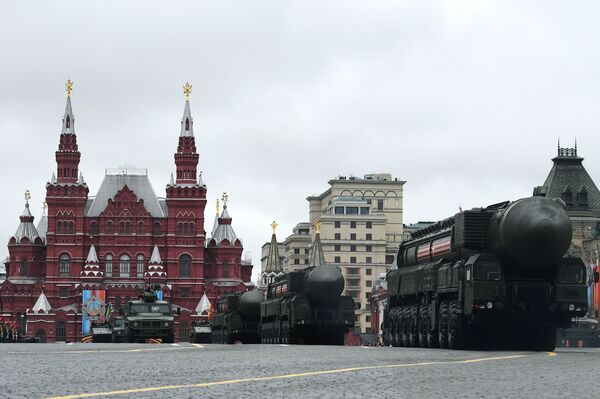Earlier this week, the Russian Ministry of Defense announced that ten Strategic Missile Forces regiments (i.e. up to 90 mobile Topol-M and RS-24 Yars ground-based intercontinental ballistic missile launchers) would begin drilling later this month. The elite units will practice everything from movement, to prepping launch positions, to 'maskirovka', a term describing the use of camouflage, denial and deception to thwart the prospective adversary's attempts at aerial reconnaisance and sabotage.
"In the second half of June, missile regiments will begin exercises in field positions in the Tver, Novosibirsk, Sverdlovsk, Kirov, Irkutsk and Ivanovo regions," the MoD's press service confirmed.
The scale of the drills is serious enough. A single Topol-M launcher carries a lone 800 kiloton warhead, but its design also enables it to deploy multiple warheads, using what's known as a multiple independently targetable reentry vehicle (MIRV). As for the RS-24 Yars, that system is MIRV equipped from the get-go, with each missile containing at least 4 MIRVs, each armed with 150-250 kiloton warheads. In other words, the drills taking place later this month will involve units which are hypothetically capable of launching hundreds of Russia's deadliest and most advanced nuclear missiles.
According to Kotz, the upcoming exercises may be a response to US and NATO activity along Russia's western borders.
Kotz pointed out that routine or not, it's no secret that the B-52 and the B-1B are the backbone of the air component of the US nuclear triad. Each plane is capable of carrying ALCM AGM-86 nuclear cruise missiles, which feature a 200 kiloton warhead and have a range of over 2,500 km. This, the journalist stressed, is "more than enough to cover the major cities in the western part of Russia, beginning from the Baltic coast of Estonia." In other words, "it's no surprise that the Russian Aerospace Defense Forces promptly scrambled fighters to escort the US bombers; leaving such targets unattended would simply be foolish."
Earlier this week, Polish President Andrej Duda said that he intends to discuss increasing the US military presence in his country with US President Donald Trump next month. This may include talks on expanding the US missile defense system components presently being deployed in the Eastern European country.
"We have repeatedly stated that we will not ignore the strengthening of various contingents by the NATO Bloc…Of course, countermeasures will be taken," Shvitkin stressed.
One of these 'countermeasures', according to Kotz, probably includes the large-scale exercises involving Russia's Missile Forces scheduled for later this month. The military observer recalled that the last major strategic missile maneuvers were held back in March; in those drills, nine regiments were involved. Those drills had coincided with the US deployment of its THAAD missile defense system in South Korea, and amid the latest sharp exchanges between US and Russian diplomats over Washington's ongoing construction of its missile defense system in Poland and Romania.
In other words, the Strategic Missile Forces and their Topol-M and Yars missile systems seem to have their own 'diplomatic' note to play in at least checking excessive US and NATO ambitions.
"The main advantage of the Topol-M and Yars mobile ground missile systems is their mobility," Kotz explained. "In case of the threat of full-scale war, they go on combat patrol, and get 'lost' to enemy satellites and spies in the vast expanses of Russia. It becomes nearly impossible to track them."
"In addition, counter-sabotage units attached to each missile regiment will also take part in the maneuvers. During the exercises, they will carry out the tasks of locating, blocking and destroying saboteurs, using the Typhoon-M armored vehicles recently adopted into service and unmanned aerial vehicles," Kotz noted.

Late last month, Russian Minister of Defense Sergei Shoigu revealed that by the end of 2017, two thirds of the Strategic Missile Forces would be fully equipped with new weapons and equipment.
That's a pretty impressive statistic, Kotz wrote, "considering that only a decade ago almost the entire nuclear shield consisted of systems which had entered combat duty in the Soviet period."






